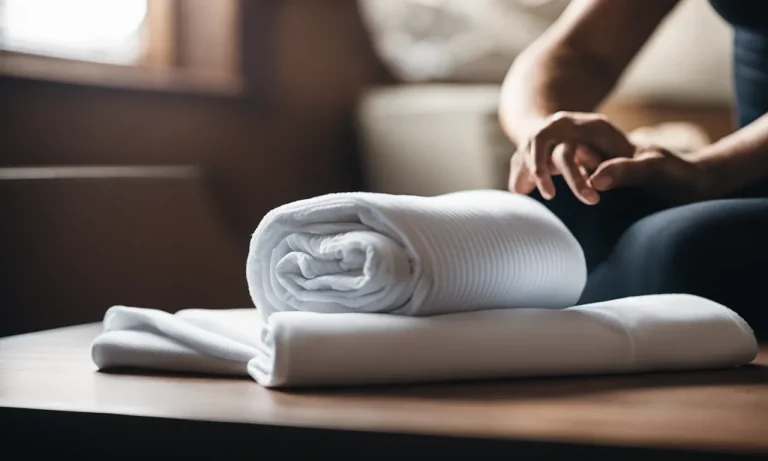How To Thread A Sewing Machine Bobbin: A Step-By-Step Guide
Sewing machines can seem complicated at first, but learning how to properly thread your bobbin is a key skill for any sewist. Whether you’re working with a new machine or encountering bobbin issues on your tried-and-true model, this comprehensive guide will walk you through the bobbin threading process step-by-step.
If you’re short on time, here’s a quick answer to your question: Wind the bobbin thread evenly around the bobbin case, pull the thread through the tension spring, lead the thread under the tension disk and out of the bobbin case, then insert the bobbin case into the sewing machine and pull the thread through the slot.
Understanding Bobbin Basics
When it comes to sewing machines, the bobbin plays a crucial role in creating beautiful and sturdy stitches. The bobbin is a small, spool-like device that holds the lower thread, which is essential for creating the bottom stitches on your fabric.
It works in tandem with the upper thread, which is threaded through the needle, to create a balanced stitch. Without a properly threaded bobbin, your stitches may be loose, uneven, or may not even form at all.
The Role of the Bobbin
The bobbin serves as the foundation for the stitches you create with your sewing machine. It holds the thread that loops around the upper thread, creating a lock that secures the stitches in place. As the needle passes through the fabric, the bobbin thread is pulled up, interlocking with the upper thread to form a strong and durable stitch.
It’s important to note that the bobbin thread is typically a different color than the upper thread. This distinction helps sewers identify any tension issues or thread snags more easily. By understanding the role of the bobbin and how it interacts with the upper thread, you can troubleshoot stitching problems and make adjustments as needed.
Types of Sewing Machine Bobbins
Sewing machine bobbins come in various shapes and sizes, depending on the make and model of your machine. The most common types of bobbins are metal and plastic. Metal bobbins are typically found in older, vintage sewing machines, while plastic bobbins are more common in modern machines.
Additionally, there are different styles of bobbins, such as class 15 bobbins, which are used in many home sewing machines, and class 66 bobbins, which are used in some industrial machines. It’s important to consult your sewing machine’s manual or manufacturer’s website to determine the specific type of bobbin your machine requires.
Understanding the basics of bobbins is essential for anyone looking to thread their sewing machine correctly. By knowing the role of the bobbin and the different types available, you can ensure that your machine operates smoothly and produces high-quality stitches.
Prepare the Bobbin
Winding the Bobbin
Before you can thread your sewing machine bobbin, you need to wind it first. Start by selecting the thread color that matches your project. Make sure you have an empty bobbin ready to be wound. Most sewing machines have a built-in bobbin winder, which is usually located on the top or front of the machine.
To wind the bobbin, follow these steps:
- Place the thread spool on the spool pin and secure it with the spool holder.
- Take the end of the thread and thread it through the bobbin winding tension disc, if your machine has one.
- Slide the empty bobbin onto the bobbin winder spindle.
- Hold the end of the thread and start the bobbin winding process. Some machines have a start/stop button, while others require you to press the foot pedal.
- Continue winding the bobbin until it is almost full. Be careful not to overfill it, as it may cause tension issues while sewing.
- Cut the thread and remove the bobbin from the winder spindle.
Now that your bobbin is wound, it’s time to insert it into the sewing machine.
Inserting the Bobbin Case
The next step in threading your sewing machine bobbin is to insert the bobbin case. The bobbin case holds the bobbin and helps to regulate the thread tension while sewing. Follow these steps to insert the bobbin case:
- Locate the bobbin case in your sewing machine. It is usually located under the needle plate, which can be removed by unscrewing a small screw or sliding a latch.
- Insert the wound bobbin into the bobbin case, making sure the thread is coming off the bobbin counterclockwise.
- Hold the bobbin case with your thumb and forefinger and pull the thread through the slot or around the tension spring, depending on your machine’s design.
- Place the bobbin case back into the sewing machine, ensuring it is correctly positioned and securely locked in place.
- Replace the needle plate and tighten the screw or latch to secure it.
Now that you have prepared the bobbin and inserted the bobbin case, you are ready to thread the sewing machine and start your sewing project.
Thread the Bobbin Case
Lead the Thread Through the Tension Spring
When threading the bobbin case, the first step is to lead the thread through the tension spring. This small metal piece is responsible for regulating the tension of the thread as it is wound onto the bobbin.
To do this, simply pass the thread through the small hole or loop located on the tension spring.
Pass the Thread Under the Tension Disk
Once the thread has been threaded through the tension spring, the next step is to pass it under the tension disk. The tension disk is usually a flat metal or plastic piece with a small groove or slot. Insert the thread into the groove and make sure it is securely held in place by the disk.
This will ensure that the thread is properly tensioned as it is wound onto the bobbin.
Pull the Thread Through the Side Slot
After passing the thread under the tension disk, the final step is to pull it through the side slot of the bobbin case. The side slot is typically located on the edge of the bobbin case and is designed to guide the thread as it is wound onto the bobbin.
Gently pull the thread through the slot, making sure it is not tangled or caught on any other parts of the bobbin case.
It is important to note that the specific steps for threading the bobbin case may vary slightly depending on the make and model of your sewing machine. Always refer to the manufacturer’s instructions for the most accurate and detailed guidance.
Additionally, there are numerous online tutorials and videos available that can provide visual demonstrations of this process.
For more detailed instructions on how to thread a sewing machine bobbin, you can visit websites such as sewing.com or thesprucecrafts.com. These websites offer step-by-step guides with helpful images and tips to ensure successful bobbin threading.
Insert the Bobbin Into the Machine
Inserting the bobbin into the sewing machine is a crucial step in the threading process. Follow these steps to ensure proper insertion:
Place the Bobbin in the Bobbin Housing
The bobbin housing is usually located below the needle plate of the sewing machine. Start by removing the bobbin case from the machine, if necessary. Then, take the bobbin and hold it so that the thread is coming off the top.
Place the bobbin into the bobbin housing, making sure it fits snugly and is correctly oriented according to the machine’s instructions. Some machines require the bobbin to rotate clockwise, while others may require it to rotate counterclockwise.
Consult your sewing machine’s manual for specific instructions.
Pull the Thread Through the Slot
Once the bobbin is securely placed in the housing, locate the slot or guide specifically designed for pulling the thread through. This slot is usually located on the side of the bobbin housing or near the bobbin area. Take the end of the thread from the bobbin and pull it through the designated slot.
Ensure that there is enough thread pulled through to comfortably reach the needle and allow for sewing without any tension issues. You may need to hold onto the end of the thread to prevent it from being pulled back into the housing.
For a visual demonstration of how to insert the bobbin into your specific sewing machine, consider checking out this helpful video tutorial by a sewing expert. Remember to always refer to your sewing machine’s manual for precise instructions, as different machines may have slight variations in the threading process.
Tension Tips and Troubleshooting
Adjusting Bobbin Tension
Proper tension is crucial for achieving high-quality stitches when sewing with a machine. When it comes to bobbin tension, it can be adjusted to ensure that the upper and lower threads are properly balanced. If the bobbin tension is too tight, the stitches may pucker or break.
On the other hand, if the bobbin tension is too loose, the stitches may appear loopy or uneven.
Adjusting the bobbin tension is a delicate process and may vary depending on the sewing machine model. It is recommended to consult the sewing machine’s manual for specific instructions on how to make tension adjustments.
Generally, the tension can be adjusted by turning a tiny screw located on the bobbin case. It is important to make small adjustments at a time and test the stitches to see the impact of the changes.
Fixing Common Bobbin Issues
While sewing, you may encounter common bobbin issues that can be easily resolved. One of the most common issues is a jammed bobbin. This occurs when the thread gets tangled or caught in the bobbin case. To fix this, turn off the sewing machine and carefully remove the bobbin case.
Gently untangle the thread and remove any lint or debris that may be causing the jam.
Another common issue is when the bobbin thread doesn’t come up through the fabric. This can be caused by incorrect threading or a lack of tension. Make sure that the bobbin is properly inserted and threaded according to the machine’s instructions.
Adjust the tension if necessary to ensure that both threads are properly balanced.
If you are experiencing skipped stitches or uneven tension, it may be due to a worn-out or damaged bobbin case. In such cases, it is recommended to replace the bobbin case to resolve the issue.
Remember, troubleshooting bobbin issues may require some trial and error. It is important to be patient and take your time to identify and resolve any problems. If you are unsure or unable to fix the issue, it is always a good idea to seek assistance from a professional or refer to the sewing machine manufacturer’s website for further guidance.
Conclusion
Following the proper step-by-step process is crucial for threading your sewing machine bobbin correctly. By understanding how the bobbin works, preparing it properly, threading the bobbin case, inserting the bobbin into the machine, and making any tension adjustments, you’ll be stitching away in no time.
With some practice and patience, you’ll become a bobbin threading expert!







